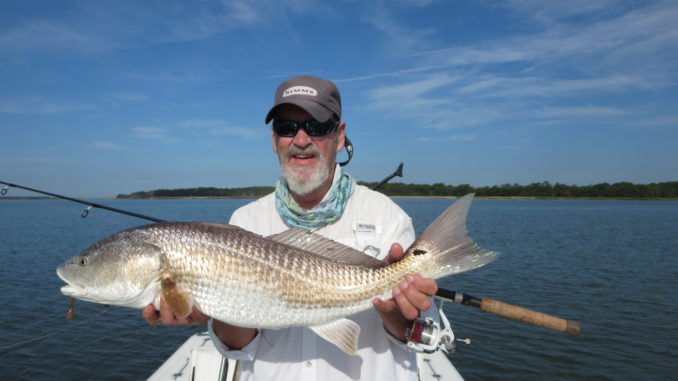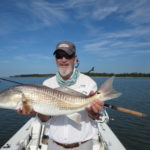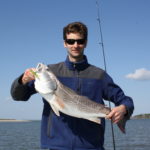
Match your retrieve to the mood of late-fall redfish for the best Carolinas action.
Who’s right?
You’ve read the articles, watched fishing shows and videos and fished with guides or other so-called experts, and they give conflicting advice on how to catch redfish. Those who fish with bait know catching reds is pretty straight forward: drop live or dead bait into a likely spot and wait until something eats it. Yes, there are many subtleties to presenting the bait into the right spots, but if the fish are hungry, they will eat.
That’s not necessarily the case when fishing with artificial lures and flies. When the offering doesn’t look or smell anything like food, an angler needs to impart some action or movement to the lure to fool a fish into striking. The jighead with a plastic trailer is the most-iconic artificial lure used to fool Lowcountry redfish. Fished slowly with a bouncing action, a jig and trailer imitates a mud minnow, crab or shrimp. Retrieved more quickly, it looks like any of our other baitfish fleeing from a predator.
Redfish are opportunity feeders that will strike lures presented both slowly and aggressively. Some superb Lowcountry guides prefer slow retrieves that keep the lure in the strike zone for the longest possible time. Other equally good guides prefer enticing reaction strikes with a rapid retrieve. Of course, guides and the best fishermen know both techniques and use them when appropriate, but they gravitate to their favorites. Which way is best? It depends.
A survey asked several guides how they retrieve a lure when they see a school of redfish. Mark Nutting of Hilton Head said it depends on the attitude of the fish, but generally, “kind of quickly.” When you find feeding fish, a cast close to the edge of the school that is quickly retrieved normally prompts a strike. Tuck Scott of Beaufort suggested two different options for fish that are cruising slowly. Cast well beyond the leading edge of the fish and retrieve the lure at a constant, slow speed or the “drop-and-wait” technique where you cast several feet in front of the school and let the lure sit on the bottom until the fish reach it before jigging.
When casting a jig, Beaufort’s Owen Plair is mostly trying to match the action of the hatch, which in November is often shrimp. His favorite retrieve is holding the rod low to the water and lightly twitching the tip every third turn of the reel, giving the jig a shrimp-like jump.
“Imagine a slowly swimming shrimp that pops every so often like its running away,” he said.
The retrieve also imitates a darting minnow or any other kind of baitfish. Owen hardly ever uses a fast retrieve, while other experts suggest almost hitting the fish on the head and retrieving the jig very quickly for instinct strikes. With either slow or fast retrieves, the hook set still must be aggressive.
When the guides don’t see any fish but are just “blind casting” to productive-looking water such as a grass line or an oyster out-cropping, their technique changes. The deeper the water is near the grass, the more the retrieve slows down.
Doug Gertis of Beaufort likes to make the jig touch the bottom near the grass or structure, then hop it back for only a few feet, then reel in for a new cast. He said the productive strike zone for redfish is only the 3 to 4 feet nearest the grass, so there is no need to work the lure all the way to the boat.
Late fall is probably the easiest time to catch redfish. The water is cooling down and becoming clearer, and the fish are beginning to congregate in larger schools which are easier to spot. The falling water temperature foretells winter’s cold, so redfish feed aggressively in shallows throughout the day to store fat for winter’s lean times.
When surveying guides, getting a definitive answer to the simple question “Which is best?” it is difficult because they see what the fish are doing — “their attitude” as Nutting said, and their vast experience tells them exactly where to drop the lure and how fast to retrieve it. Most of the time they’re right and get hooked up. To generalize, however, if you see a school of redfish, especially if they are feeding, get the lure close to them and move it away pretty quickly like it is prey trying to escape. If you don’t see any fish, cast to likely spots and move the lure more slowly. Focus on the first few feet nearest the structure.
Then again — it depends.
DESTINATION INFORMATION
HOW TO GET THERE — Anglers working the Broad River areas often use the excellent landing located on SC 170 at the Chechessee River bridge, half way between Bluffton and Beaufort, or the landing below the Broad River Bridge. Beaufort River anglers can put in at the Sands landing near downtown Port Royal. The landing at the foot of the Fripp Island Bridge gives access to the outer islands. Many other free public landing options are available.
WHEN TO GO — Redfish action in the Lowcountry can be great through Thanksgiving and into, even through December depending on the weather. Reds are easiest to find at low tide.
FISHING INFO/GUIDES — Bay Street Outfitters, Beaufort, 843-524-5250; Grayco Hardware, Lady’s Island, 843-521-8060; Beaufort Boat and Dock Supply, Port Royal, 843-986-0552; Capt. Tuck Scott, 843-271-5406, Capt. Owen Plair 843-524-5250; Capt. Doug Gertis 843-521-9896, Capt. Dan Utley 843-368-2126, Capt. Jack Brown, 843-838-9369, Capt. Richard Sykes, 843-524-5250, Capt. Danny Rourke, 843-263-3863; Capt. Mark Nutting, 843-540-7302. See also Guides and Charters in Classifieds.
ACCOMMODATIONS — Beaufort Area Chamber of Commerce, 843-986-5400, www.beaufortchamber.org.
MAPS — iTop Spot Waterproof map N233 is available at most local tackle shops. Waterproof Chart 93 is available at 800-423-9026, www.waterproofcharts.com.



Be the first to comment